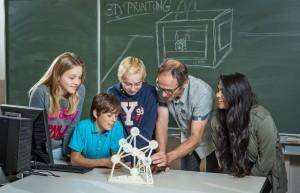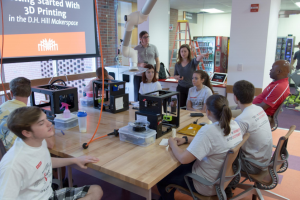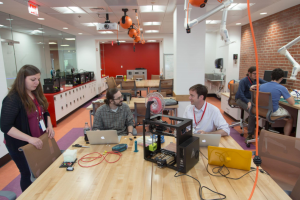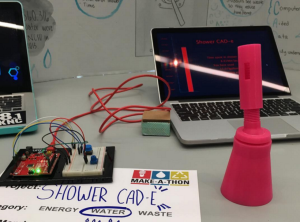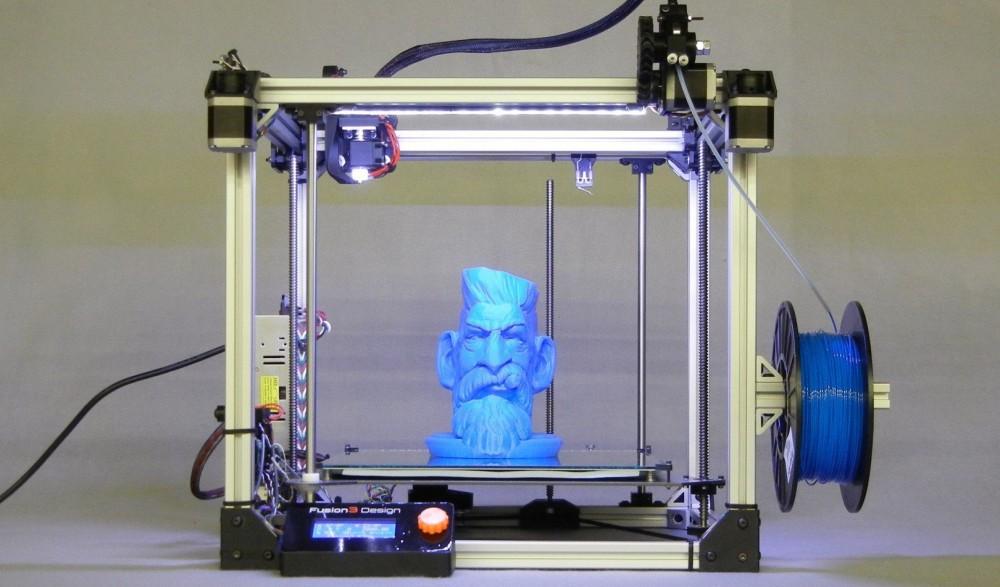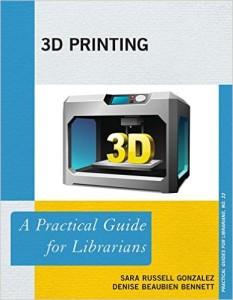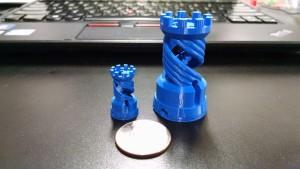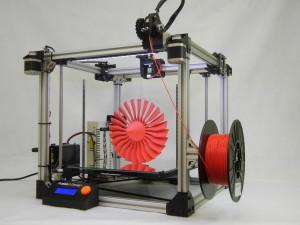Thinking Beyond the Desktop: University Libraries are Turning to Fusion3 Industrial 3D Printers to Make a Makerspace that Will Last
 For the 3D printing industry, 2014 was defined primarily by the major printer manufacturers moving quickly and aggressively to educate the public on 3D printing and to get their desktop printers into homes and offices. For most companies the result was a success, which led to a huge increase in sales and a rapid expansion of the 3D printing industry as a whole. But as the hype started to die down, sales of desktop 3D printers started to slow, resulting in those same companies switching gears and focusing on the education market. Getting 3D printers into classrooms, school libraries and educational settings seemed to be a priority throughout most of 2015.
For the 3D printing industry, 2014 was defined primarily by the major printer manufacturers moving quickly and aggressively to educate the public on 3D printing and to get their desktop printers into homes and offices. For most companies the result was a success, which led to a huge increase in sales and a rapid expansion of the 3D printing industry as a whole. But as the hype started to die down, sales of desktop 3D printers started to slow, resulting in those same companies switching gears and focusing on the education market. Getting 3D printers into classrooms, school libraries and educational settings seemed to be a priority throughout most of 2015.
One Thing is Not Like the Other: Where the Classroom Ends and the Library Begins
While the industry’s attention of the education market was somewhat successful, and any 3D printer is going to dramatically enhance a classroom environment, many higher education libraries who already had makerspaces and printing labs were beginning to discover the limitations of most desktop 3D printers. When 3D printer manufacturers talk about positioning their printers into educational environments they often lump classrooms and libraries together. On some level it makes sense; after all, both environments seek to serve similar purposes, so it is easy to understand why companies typically don’t treat them as different markets.
However, despite any superficial similarities between the two, libraries and classrooms are actually two extremely different environments with very different purposes and sets of requirements — especially as many libraries seek to enhance their available services by offering fully equipped makerspaces. While it may seem odd for libraries to start offering their users access to manufacturing equipment, in reality bringing in new technology is par for the course. To put it simply, the purpose of a classroom is to educate while the purpose of a library is to make available the tools to educate.
The distinction between a classroom and a library may not seem like much, but understanding that distinction is vital to any company hoping to serve both. Classrooms regularly bring in a wide variety of educational materials, including tools, computers and most recently 3D printers. However, these are all elements of a pre-set curriculum and play specific, and often limited or restricted, roles in the overall educational plan developed by the faculty. Libraries, on the other hand, have no set curriculums, and those who visit them generally do so of their own volition and are often in search of very specific educational materials and equipment. While the tools and equipment that an individual library will offer has always varied from location to location, one thing about libraries has always been consistent: they will always make efforts to offer their users as many educational tools as possible.
More than Books: The Library Makerspace Revolution
Libraries have always been more than books really, and historically many have offered their users access to a wide variety of equipment like cameras, computers, digital media and, yes, manufacturing tools. With the recent, and dramatic, drop in price of modern additive manufacturing equipment, robotics and other forms of technology, it’s only natural that libraries would bring as many of those tools to their users as possible. And as with classrooms, many libraries eagerly brought in modern desktop 3D printers, and even started converting floor space into large makerspaces and workshops. Many of these new makerspaces found themselves wildly successful and attracted new users in droves. But many libraries, especially those on college and university campuses, discovered that 3D printer selection was a vitally important part of creating a successful and high-functioning makerspace.
“We started our 3D printing service when we opened the new James B. Hunt Jr. Library in January 2013, and from the start made the service open to all students, faculty, and staff. We were inundated with users and files to print pretty quickly. Luckily, as a librarian, I’m trained to know how to research and find information, so I set about learning and mastering the hardware, software, and materials. Also, I was able to hire some amazing student workers, most of whom had 3D design (if not 3D printing) experience,” Adam Rogers, the Emerging Technology Services Librarian from North Carolina State University explained to me via email.
The makerspace program at NCSU started rather conservatively with a set of MakerBot Replicator 2’s and an industrial quality uPrint SE Plus from Stratasys. However, since its inception it has grown dramatically in size and scope and currently consists of two different spaces in two different campus libraries. Not only do they offer a large selection of 3D printers, they also have a robust Technology Lending Program and provide support for many college courses that require familiarity with or access to the equipment in the makerspace. The libraries also offer a series of workshops that teach 3D printing, 3D scanning, Arduino, the Internet of Things, sewing and wearable electronics.
“That said, we certainly had a lot of issues with our 3D printers. None of the MakerBots worked out of the box, and we experienced a lot of jamming and sticking issues with them. Gradually, we made many mods to them, including adding glass build plates, extruder upgrades, and more. this improved things, but they seemed to continually break down with high-volume use in our environment,” Rogers continued.
NCSU’s Hunt Library Makerspace offers full-service 3D printing to any NCSU student or faculty member, charging only based on the amount of material used. The second makerspace location, at D.H. Hill Library, is geared to students and faculty who desire unsupervised use of 3D printers and other equipment on their own. Despite their uPrint holding up well under the stress of the high volume of use, the limitations of the original desktop 3D printers made it clear to Rogers and the rest of the library staff that they needed to explore more 3D printer options. While they had not yet made a decision to actively seek new, more robust printers when Rogers met Fusion3 founder and CEO Chris Padgett, a free trial and demonstration of the Fusion3 F306 won them over rather quickly.
“We put the printer on display in the Hunt Library’s Technology Showcase, and put it through its paces. We were really impressed by its performance and reliability. A major selling point was having local support, and a service plan available. We have grown pretty adept at fixing machines—at least three of my library colleagues could now put “3D printer mechanic” on their resumes—but sometimes you need new parts, or good phone support to get the job done. For a service that we are making available to all of our students and campus community, uptime is really important, and we knew good support and service was crucial to that,” said Rogers.
As an alum of NC State University, Padgett had a natural “in” with the NCSU library program, who were eager to support a former student. However, what was being offered in the sales pitch still had to match reality, and the F306 is an impressive 3D printer that had plenty to offer the NCSU makerspace. It is constructed from high-quality parts, a solid and sturdy aluminum frame, and has a simple, low-maintenance design that is ideal for high-volume operations. Combine that with a 12 inch x 12 inch x 12 inch printing envelope, a multi-zone heated printing bed that was designed to be just as functional as printers with an enclosure, and the ability to print with more than thirty filament materials, and it is easy to see why the F306 is so attractive to busy makerspaces.
In the Library: Making Successful Makerspaces
As with most librarians, especially those found at university, science or research libraries, Sara Gonzalez speaks about makerspaces from a position of authority. As the Physical Sciences, Mathematics, and Visualization Librarian for the University of Florida and a former geophysicist with extensive research experience with emerging technologies, data visualization and scientific literacy instruction, she is about as ideal a candidate as you can get to build a makerspace. She has even, literally, written the book on bringing 3D printing technology into libraries. 3D Printing: A Practical Guide for Librarians, written with her co-author, UFL Engineering Librarian Denise Beaubien Bennett, is due to be released in March. The book is drawn heavily from the pair’s experiences as early 3D printing technology adopters and from the development of their highly successful, academic library-based makerspaces on the University of Florida campus.
“We purchased the Fusion3 printers based upon recommendation from other academic libraries and because their specifications met our needs. We liked the build quality of their printers and have been very pleased with the level of support provided. Our patrons needed larger build volumes along with a heated build plate to help models adhere and avoid warping. We were also dealing with an increase in jobs and so needed faster printers to manage the queue. We have new patrons who now use us for 3D printing because of the [Fusion3 F306’s],” Gonzalez, from the University of Florida’s Marston Science Library, told me.
Similarly to the makerspaces at NCSU, the makerspace at the University of Florida started modestly with a handful of MakerBots. Their Makerbot Replicator 2’s eventually became supplemented by some new MakerBot Replicator 5th gens and several Printrbot Simple Metals that they use in community workshops and loan out to local educators. When I asked Gonzalez if higher quality 3D printers were worth makerspaces investing in, she was pretty adamant that if it was a large location that had a high demand placed on model quality, printing size and strength, she would recommend higher-end 3D printers. They’ve recently acquired four Fusion3 F306’s to handle the high workload of their user base, which includes students, researchers, faculty, and the general public.
“When we started Fusion3, it was clear there are customers who can’t justify the expense of an industrial printer and require greater performance and durability than what the consumer brands offer. It’s gratifying to know that our printers are able to fill this role and support new use cases like the library makerspace; customers who need a fast, accurate printer that’s also durable and can withstand the use and abuse of a makerspace,” Fusion3 CEO Chris Padgett told me via email.
Makerspaces: The Library of the Future
The role of makerspaces in libraries, especially those in universities, is evolving rapidly. As 3D printing becomes more accepted and understood by the general public the demand for 3D printing services is only going to rise. Currently library makerspaces are often a nice feature on many higher education campuses; however, within a few years it is obvious that they’re going to be a requirement — especially as an entirely new generation of students who are used to working with 3D printers in classroom environments begin graduating from high schools. When they move on to academia it is only natural that they will expect not only a higher level of educational standards, but a higher level of 3D printing and technology available to them.
We know from experience that just like libraries, no makerspace is ever going to be exactly like another. The individual needs of the communities, schools and students who use them will always need to be considered. In all but the rarest of cases, budgets for opening new makerspaces are always going to be extremely tight. The impulse is often to save money anywhere that you can, and to be fair, there are plenty of high-quality and reliable desktop 3D printers available. But even the best desktop printer is going to have limitations in printing speed, quality and reliability.
As a makerspace grows in both popularity and use, desktop printers are simply going to be incapable of keeping up with the demands being placed on them. At some point new 3D printers are going to be needed, so sometimes an investment in something with a higher initial cost on the outset can add up to some impressive savings down the line. Maintenance costs alone can turn a standard desktop 3D printer being used in a high volume space into a needlessly costly recurring expense. When you add in any lost printing time due to machine downtime those costs can get even larger.
It seems that some of the country’s best makerspaces are making the leap into industrial quality 3D printers despite any additional costs because it just makes financial sense to invest in machines that are faster and more robust. Companies like Fusion3 didn’t develop their 3D printers for a home or a garage maker who would use it on weekends; they were created for extremely high-demand and high-volume manufacturing and are capable of being run virtually non-stop, day and night. Based on the speed, build volume and print quality, one Fusion3 F306 could easily do the job of three or four standard desktop printers.
If you find yourself opening a makerspace, then it is entirely possible that you will never need that type of high-volume production and consistency. But given the continued expansion of the 3D printing industry, the entirely new industries popping up that are finding new and innovative ways to use 3D printing technology, and the growing number of students who are growing up with access to 3D printers, you may want to be sure about that. It is evident that 3D printing is a key component of starting up a modern makerspace, and the experts at doing it all seem to agree that 3D printer selection is absolutely vital to that new makerspace’s success. Discuss in the Fusion3 F306 3D Printer forum over at 3DPB.com.
Subscribe to Our Email Newsletter
Stay up-to-date on all the latest news from the 3D printing industry and receive information and offers from third party vendors.
You May Also Like
Meltio Expands Global Reach with New Partnerships in the Americas and Europe
Spanish 3D printing manufacturer Meltio has expanded its sales network across the globe. With the addition of three new partners in the United States, Brazil, Argentina, and Italy, Meltio aims...
3D Printing Webinar and Event Roundup: April 7, 2024
Webinars and events in the 3D printing industry are picking back up this week! Sea-Air-Space is coming to Maryland, and SAE International is sponsoring a 3D Systems webinar about 3D...
On the Ground in Linares, Spain for the Meltio M600 Launch
As detailed in a previous post, metal 3D printer manufacturer Meltio launched its latest wire-laser metal deposition (LMD) machine, the Meltio M600, at its headquarters in Linares, Spain. There, I was...
Blue Laser-powered M600 3D Printer Launched by Meltio
Founded in 2019 as a joint venture between Additec and Sicnova, metal 3D printer OEM Meltio develops and manufactures high-performance and easy-to-use metal 3D printing solutions that use its patented wire-laser metal...


